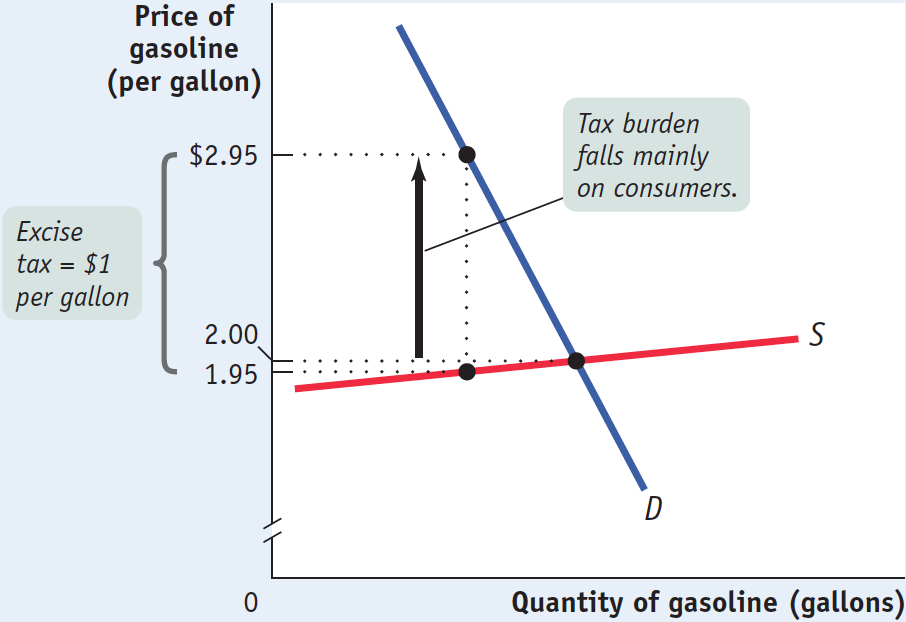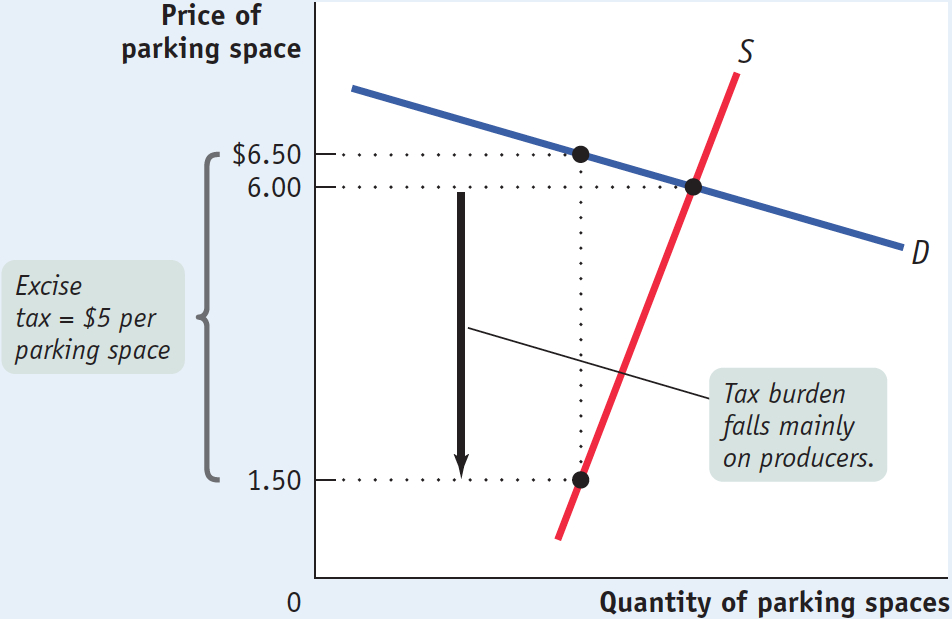Price Elasticities and Tax Incidence
We’ve just learned that the incidence of an excise tax doesn’t depend on who officially pays it. In the example shown in Figures 7-1, 7-2, and 7-3, a tax on hotel rooms falls equally on consumers and producers, no matter who the tax is levied on.
But it’s important to note that this 50-
What determines how the burden of an excise tax is allocated between consumers and producers? The answer depends on the shapes of the supply and the demand curves. More specifically, the incidence of an excise tax depends on the price elasticity of supply and the price elasticity of demand. We can see this by looking first at a case in which consumers pay most of an excise tax, then at a case in which producers pay most of the tax.
When an Excise Tax Is Paid Mainly by Consumers Figure 7-4 shows an excise tax that falls mainly on consumers: an excise tax on gasoline, which we set at $1 per gallon. (There really is a federal excise tax on gasoline, though it is actually only about $0.18 per gallon in the United States. In addition, states impose excise taxes between $0.17 and $0.53 per gallon.) According to Figure 7-4, in the absence of the tax, gasoline would sell for $2 per gallon.

Two key assumptions are reflected in the shapes of the supply and demand curves in Figure 7-4. First, the price elasticity of demand for gasoline is assumed to be very low, so the demand curve is relatively steep. Recall that a low price elasticity of demand means that the quantity demanded changes little in response to a change in price—
We have learned that an excise tax drives a wedge, equal to the size of the tax, between the price paid by consumers and the price received by producers. This wedge drives the price paid by consumers up and the price received by producers down. But as we can see from Figure 7-4, in this case those two effects are very unequal in size. The price received by producers falls only slightly, from $2.00 to $1.95, but the price paid by consumers rises by a lot, from $2.00 to $2.95. In this case consumers bear the greater share of the tax burden.
This example illustrates another general principle of taxation: When the price elasticity of demand is low and the price elasticity of supply is high, the burden of an excise tax falls mainly on consumers. Why? A low price elasticity of demand means that consumers have few substitutes and so little alternative to buying higher-
This gives producers much greater flexibility in refusing to accept lower prices for their gasoline. And, not surprisingly, the party with the least flexibility—
When an Excise Tax Is Paid Mainly by Producers Figure 7-5 shows an example of an excise tax paid mainly by producers, a $5.00 per day tax on downtown parking in a small city. In the absence of the tax, the market equilibrium price of parking is $6.00 per day.

We’ve assumed in this case that the price elasticity of supply is very low because the lots used for parking have very few alternative uses. This makes the supply curve for parking spaces relatively steep. The price elasticity of demand, however, is assumed to be high: substitutes are readily available as consumers can easily switch from the downtown spaces to other parking spaces a few minutes’ walk from downtown, spaces that are not subject to the tax. This makes the demand curve relatively flat.
The tax drives a wedge between the price paid by consumers and the price received by producers. In this example, however, the tax causes the price paid by consumers to rise only slightly, from $6.00 to $6.50, but causes the price received by producers to fall a lot, from $6.00 to $1.50. In the end, consumers bear only $0.50 of the $5.00 tax burden, with producers bearing the remaining $4.50.
Again, this example illustrates a general principle: When the price elasticity of demand is high and the price elasticity of supply is low, the burden of an excise tax falls mainly on producers. A real-
Some of these towns have imposed taxes on house sales intended to extract money from the new arrivals. But this ignores the fact that the price elasticity of demand for houses in a particular town is often high, because potential buyers can choose to move to other towns. Furthermore, the price elasticity of supply is often low because most sellers must sell their houses due to job transfers or to provide funds for their retirement. So taxes on home purchases are actually paid mainly by the less well-
Putting It All Together We’ve just seen that when the price elasticity of supply is high and the price elasticity of demand is low, an excise tax falls mainly on consumers. And when the price elasticity of supply is low and the price elasticity of demand is high, an excise tax falls mainly on producers. This leads us to the general rule: When the price elasticity of demand is higher than the price elasticity of supply, an excise tax falls mainly on producers. When the price elasticity of supply is higher than the price elasticity of demand, an excise tax falls mainly on consumers.
So elasticity—
ECONOMICS in Action: Who Pays the FICA?
Who Pays the FICA?
Anyone who works for an employer receives a paycheck that itemizes not only the wages paid but also the money deducted from the paycheck for various taxes. For most people, one of the big deductions is FICA, also known as the payroll tax. FICA, which stands for the Federal Insurance Contributions Act, pays for the Social Security and Medicare systems, federal social insurance programs that provide income and medical care to retired and disabled Americans.

In 2014, most American workers paid 7.65% of their earnings in FICA. But this is literally only the half of it: each employer is required to pay an amount equal to the contributions of its employees.
How should we think about FICA? Is it really shared equally by workers and employers? We can use our previous analysis to answer that question because FICA is like an excise tax—
But we already know that the incidence of a tax does not really depend on who actually makes out the check. Almost all economists agree that FICA is a tax actually paid by workers, not by their employers. The reason for this conclusion lies in a comparison of the price elasticities of the supply of labor by households and the demand for labor by firms.
Evidence indicates that the price elasticity of demand for labor is quite high, at least 3. That is, an increase in average wages of 1% would lead to at least a 3% decline in the number of hours of work demanded by employers. Labor economists believe, however, that the price elasticity of supply of labor is very low. The reason is that although a fall in the wage rate reduces the incentive to work more hours, it also makes people poorer and less able to afford leisure time.
The strength of this second effect is shown in the data: the number of hours people are willing to work falls very little—
Our general rule of tax incidence says that when the price elasticity of demand is much higher than the price elasticity of supply, the burden of an excise tax falls mainly on the suppliers. So the FICA falls mainly on the suppliers of labor, that is, workers—
This conclusion tells us something important about the American tax system: the FICA, rather than the much-
Quick Review
An excise tax drives a wedge between the price paid by consumers and that received by producers, leading to a fall in the quantity transacted. It creates inefficiency by distorting incentives and creating missed opportunities.
The incidence of an excise tax doesn’t depend on who the tax is officially levied on. Rather, it depends on the price elasticities of demand and of supply.
The higher the price elasticity of supply and the lower the price elasticity of demand, the heavier the burden of an excise tax on consumers. The lower the price elasticity of supply and the higher the price elasticity of demand, the heavier the burden on producers.
7-1
Question 7.1
Consider the market for butter, shown in the accompanying figure. The government imposes an excise tax of $0.30 per pound of butter. What is the price paid by consumers post-
tax? What is the price received by producers post- tax? What is the quantity of butter transacted? How is the incidence of the tax allocated between consumers and producers? Show this on the figure. 
Question 7.2
The demand for economics textbooks is very inelastic, but the supply is somewhat elastic. What does this imply about the incidence of an excise tax? Illustrate with a diagram.
Question 7.3
True or false? When a substitute for a good is readily available to consumers, but it is difficult for producers to adjust the quantity of the good produced, then the burden of a tax on the good falls more heavily on producers.
Question 7.4
The supply of bottled spring water is very inelastic, but the demand for it is somewhat elastic. What does this imply about the incidence of a tax? Illustrate with a diagram.
Question 7.5
True or false? Other things equal, consumers would prefer to face a less elastic supply curve for a good or service when an excise tax is imposed.
Solutions appear at back of book.